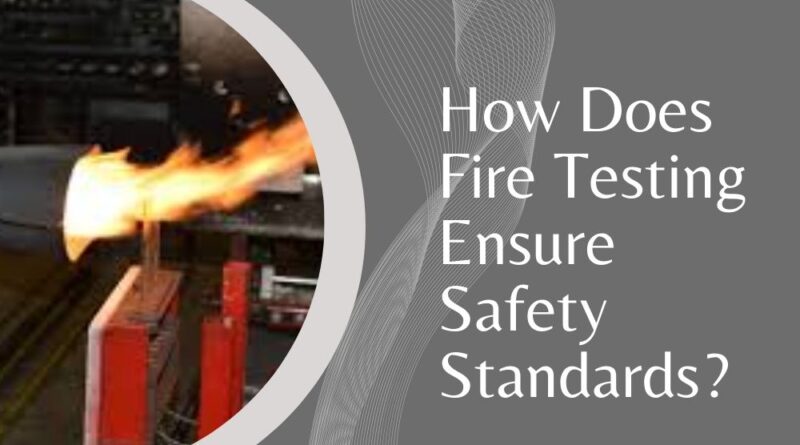How Does Fire Testing Ensure Safety Standards?
Fire testing is a crucial procedure that helps ensure the materials used in products and buildings are safe and can withstand fire conditions. This kind of testing is essential for maintaining safety and compliance across various industries. This blog will explore how fire testing works, its importance, and how it helps uphold safety standards.
Understanding Fire Testing
Fire testing involves putting materials and products through certain conditions that simulate fire to see how they react. This process helps determine how quickly a material will ignite, how much heat it will release, and how it contributes to the spread of fire. Knowing this helps manufacturers and builders use materials that enhance safety.
1. The Process of Fire Testing
The process of fire testing includes several steps:
- Preparing the Sample: A sample of the material or product is prepared according to specific standards.
- Testing in Controlled Conditions: The sample is then exposed to heat and flame in a controlled environment to monitor its reaction.
- Measuring Responses: The behavior of the material, including ignition time, burn rate, smoke production, and heat release, is carefully measured.
2. Key Metrics in Fire Testing
- Ignition Time: How long it takes for a material to catch fire.
- Burn Rate: How quickly the material burns.
- Heat Release: The amount of heat a material releases as it burns, which impacts how a fire might grow.
- Smoke Production: The amount of smoke produced, which can affect visibility and toxicity during a fire.
Why Fire Testing is Important
Fire testing is not just a routine check but a critical safety procedure. It provides valuable insights that can save lives and prevent property damage.
1. Enhancing Public Safety
Fire testing ensures that only materials that meet strict fire safety standards are used in public and private spaces. This can significantly reduce the risk of fire-related incidents and provide safer environments for people to live and work in.
2. Compliance with Regulations
Many industries are required by law to use materials that pass fire safety tests. Fire testing helps companies comply with these regulations, avoiding legal penalties and reinforcing their reputation as responsible manufacturers.
3. Reducing Property Damage
By using materials proven to resist fire better, the damage caused by fires can be minimized, saving property and reducing insurance and recovery costs.
Types of Fire Tests
Fire tests can vary depending on the material being tested and the standards it must meet. Here are a few common types of fire tests:
1. Flammability Test
This test evaluates how easily materials catch fire and how quickly they burn. It’s commonly used for textiles, building materials, and other commonly used substances.
2. Smoke Density Test
Smoke density tests measure how much smoke a material produces when it burns. This is important because heavy smoke can hinder evacuation efforts and increase the risk of inhalation injuries during a fire.
3. Fire Propagation Test
This type of test assesses how a material contributes to the spread of fire within a structure. It helps in understanding whether a material will help contain a fire or if it will act as fuel, making the fire worse.
Fire Testing Standards and Certifications
To ensure uniformity in safety measures, fire tests are conducted according to specific standards set by regulatory bodies. These standards ensure that every test is performed the same way, providing reliable and consistent results.
1. Common Fire Testing Standards
- ASTM: American Society for Testing and Materials
- ISO: International Organization for Standardization
- UL: Underwriters Laboratories
2. The Role of Certifications
After successfully passing fire tests, products often receive certifications. These certifications can be used by manufacturers to market their products as safe and compliant. They also help consumers make informed choices about the safety of the products they buy.
The Impact of Fire Testing on Industry
Fire testing has a profound impact on how industries operate and innovate. It encourages the development of new, safer materials and designs, influencing everything from consumer electronics to large-scale construction projects.
1. Driving Innovation
Knowing the fire performance of materials pushes engineers and scientists to develop safer, more resilient products. This leads to innovations in materials science, including the development of non-flammable or flame-retardant materials.
2. Enhancing Industry Standards
As materials and technologies evolve, so do the standards for fire safety. Fire testing is integral to this evolution, ensuring that safety regulations keep pace with innovation and continue to protect public health and safety.
Conclusion: Fire Testing as a Pillar of Safety
In conclusion, fire testing is a vital component of modern safety standards. It ensures that the materials and products used in everyday life are capable of withstanding fire conditions, reducing the risk of fire-related disasters. By rigorously testing and certifying products, industries not only comply with safety regulations but also protect lives and reduce property damage, contributing to a safer and more secure world.
Note:- For read more articles visit on nichenest.




